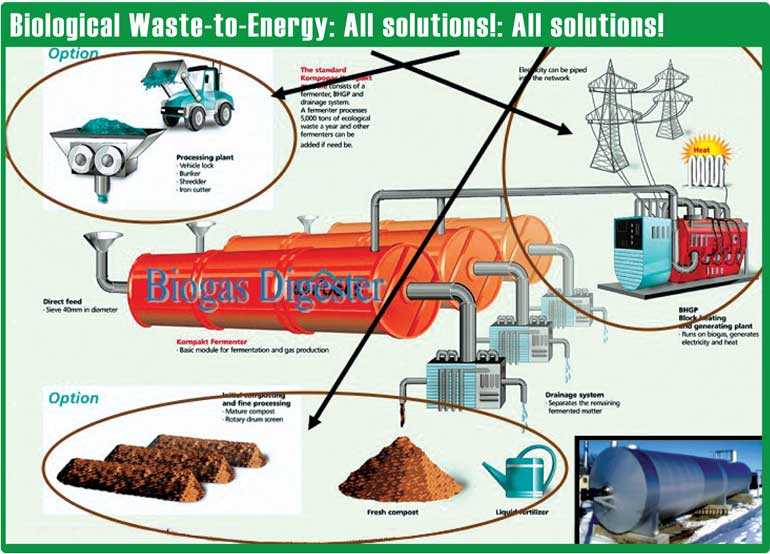Tuesday Dec 23, 2025
Tuesday Dec 23, 2025
Thursday, 19 September 2019 00:42 - - {{hitsCtrl.values.hits}}

Some appear to think of a leader just by visualising a strong person. Blindly believing with that mentality, hoping for the destination to be delivered is being naïve at its very best. I confess that I would like to see knowledge and understanding with drive built into a soul with humility, as a leader to be much more appropriate. Why this narrative at the beginning is due to a comment that was left after posting of my last column on the web!
Again I want to dive into solid waste management as there appears to be significantly erroneous communications with respect to managing Colombo solid waste. The newspapers in addition also speak of healthcare waste too becoming quite an unhealthy issue in Colombo. However one at a time and let’s take the big issue as healthcare waste is not municipal solid waste.
I commented in detail on the folly of long distance transport of waste whether by truck or by rail just to keep a city clean. It is just serving the needs of a few at the expense of many, is my view. Certainly we need to do better and we can do better and we appear to have almost done better but now appear to be throwing the baby out with the bath water! 
Waste to Energy projects
The comment that Waste to Energy (WtE) projects are too expensive and the garbage has moisture and therefore waste to energy will generate less energy are interesting statements of ignorance and the public can be easily misled as the knowledgeable are supposed to express themselves and the public is served and educated!
Your tax money is at work and the leadership is at your service doing their best and reasoning out unfortunately not so well. Yes our waste comes in mostly moist due to higher percentage of organic and green waste plus the humidity that prevails. Yes, when such waste is incinerated as the WtE option, much less energy is generated. No, the WtE process is less useful than landfill is not right. Yes, all waste management operations do incur a cost and an advanced process carries much more capital and operational costs but in turn they deliver better results. In the final statement that is the reason for looking at circular economy principles to reduce costs and realise even better results.
Our arguments are based on staying within a linear economy mode, which is not in vogue any more but proving quite difficult to get rid of – which I admit. Again the reason for indicating ‘in knowledge I trust’ and I am referring to the knowledge required to ensure a better living in the time to come and not only to be happy over the next couple of years.
Unfortunately the current science is different and we have to couple resource management, waste treatment and climate change. All these thus cannot be superficially looked at and make a judgment.
There were times even big growing cities with much economic might resorting to very easy methods in order to keep their cities clean – for example New York had barges piled high with waste from the city venturing into the sea and then simply disposing them! Now if such options are still open we have plenty of space as from down south we have the stretch of ocean till Antarctica.
New York soon found out that waves did funny things and the waste disposed using barges tended to get deposited back onto beaches elsewhere and the US courts had to put a stop to such practices. That was the end of ocean dumping as a solution and internationally the London Convention is present today. However the practice may be going on differently when one considers ship-borne waste.
Sri Lanka figures in a story of possible ocean dumping when looking at the Khaein Sea – a ship that was carrying ash from a US incinerator. Many countries refused the cargo and the last known sighting was when the ship left Colombo to Singapore. Singapore found the cargo to have vanished in between and more details are not available.

Incineration and landfill
Globally incineration and landfill are two options made use of in solid waste management by the countries with developed economies. Incineration is quite popular with countries when they lack land mass and with higher urbanisation. However, the adoption of incineration by China as it moved on with accelerated development gave incineration to have an 11% share of the global waste management methodology.
Landfills have a 40% share. Incineration with electricity generation is the popularly known WtE pathway. Volumes disappear and the heat is used to produce steam and then electricity. There are other exotic thermal pathways developed for waste management as well. It has to be indicated that Sri Lankan garbage had been proposed for all these technologies to be wedded!
We have heard and seen plasma treatment; pyrolysis, hydrothermal processing and all these had been paraded for selection. We have today settled for one mass burn incineration system and the unit is coming up. When the waste is wet as indeed it is, incineration would not yield the same amount of energy as from dry waste due to some energy being lost to remove moisture and this can be significant when the business model solely depends on sale of electricity. This also means operators would prefer to have plastics present and thus there would be no incentive to recycle.
While incineration schemes have reached significant sophistication and carry very high capital and operational costs per tonne of solid waste treated. A more difficult issue with mass burn incineration is the air pollution management and this has to be done continuously 24/7!
The issue many keeps forgetting is that multiple chemicals are needed if proper air pollution control is carried out and the residues created from all such operations mean solid waste has to be classified under hazardous which includes the bottom and top ash. With hazardous solid waste, management is even more difficult. Thermal incineration of solid waste generates a solid waste in turn, which requires special handling and disposal!
Today thermal incineration and mass landfill systems are not favoured. Mass scale sanitary landfills, which take in all waste, are on the way out due to climate issues. Thermal incinerators are on the way out due to the need for resource conservation, air pollution aspects and hazardous waste streams.
Biowaste to bioenergy
Now is there another WtE method? Instead of mass incineration one can gasify the organic and green fraction of the waste, which in Colombo may come up to about 65% by using biological treatment. This is biowaste to bioenergy! The preferred WtE scheme for Colombo and even for any other country seeking a solution for solid waste.
The organic faction has to be separated from the rest of waste and then one can easily visualise that those leftovers are potentially recyclable. That is why usually a biological WtE plant has a mechanical recovery facility at the front end. However if people diligently contribute to source separation much of the operational costs are reduced.
The most interesting aspect of a biological WtE plant is that waste is the feed and all end products are useful. There is no need for special disposal of residue, no expensive air pollution control systems. The major product is biogas and the residue, which can be both liquid and solid, are soil amendments and fertiliser. All are potential revenue streams.
Interestingly the Ministry of Megapolis led in selecting both these types of plants in addition to the landfill system that it developed. Careful management of these three may mean that Colombo can have a solution for both solid waste and other complex waste streams. Of course the operating model and revenue models can be improved on. When we complain that WtE is costly, we simply fail to understand the real costs of long distance landfilling and the other environmental externalities.
We must also distinguish between different WtE schemes too. The most interesting and the important process to watch is the anaerobic digestion plant that is coming up which is the Biological WtE plant. If some of the countries, which have invested on incineration, have the option today they would most certainly opt in for biological WtE for their organic wastes and recycle the rest. Unfortunately for them they have systems in place and when it time to retire these plants only they would opt in for bio systems.
The opportunity Sri Lanka had was not having done anything and a clean slate was available, though the picture was dirty. There is no need for short term popularity but must be scientific and future facing. The important aspect is all these developments are taking place right now.
Proper understanding backed up with more enlightened public and private partnership can mean significant benefit for Colombo right now. Let’s hope for sanity to prevail rather than half-baked science succeeding!